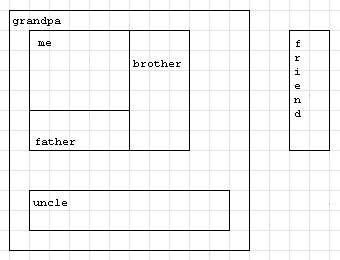CF89B Widget Library
题目描述
Vasya 编写了一款自己的图形用户界面库,并将其命名为 VTK(VasyaToolKit)。这个库的有趣之处在于控件可以相互嵌套。
在这个库中,一个控件就是图形界面中的一个元素。每个控件都有宽度和高度,占据屏幕上的某个矩形区域。所有控件都是 Widget 类型。为了方便,我们不去区分控件和它的类型。
控件类型 HBox 和 VBox 是 Widget 类型的子类,因此它们同样是 Widget 类型。HBox 和 VBox 是特别的控件,因为它们可以存放其他控件。这两种控件都有一个叫做 pack() 的方法,可以将其他控件直接打包进自身中。它们可以容纳多个控件,甚至可以重复容纳同一个控件——这样它们会分别显示在不同的位置。pack() 方法只保存引用到被打包控件的链接,因此,当被打包的控件发生变化时,作为其宿主的控件中显示的内容也会改变。
如果存在控件链 $ a=c_{1},c_{2},...,c_{k}=b $,且 $ k \geq 2 $,并且对于任何 $ 1 \leq i < k $,$ c_{i} $ 直接打包到 $ c_{i+1} $ 中,那么我们认为控件 $ a $ 被打包在控件 $ b $ 中。Vasya 的库明确禁止控件 $ a $ 打包到自身。任何尝试将控件互相打包到自身的行为都会立即引发错误。
此外,HBox 和 VBox 还有两个参数:border 和 spacing,分别由 set\_border() 和 set\_spacing() 方法设定。默认情况下,这两个参数的值都是 $ 0 $。
上图展示了 HBox 和 VBox 中控件的打包方式。HBox 和 VBox 会根据内部打包控件的大小自动调整自身尺寸。HBox 将控件水平排列,而 VBox 则是垂直排列。spacing 参数决定了相邻控件之间的距离,而 border 参数则决定了围绕所有打包控件的边框宽度。打包的控件按照调用 pack() 方法的顺序排列。如果 HBox 或 VBox 中没有控件被打包,其自身大小将为 $ 0 \times 0 $,与 border 和 spacing 参数无关。
控件都是通过一种脚本语言 VasyaScript 来创建和控制。在输入数据中可以找到这种语言的详细描述。
为了最终验证代码,Vasya 请你编写一个程序,用来计算在 VasyaScript 源代码中所有控件的尺寸。
输入格式
无
输出格式
无
说明/提示
In the first sample the widgets are arranged as follows:
